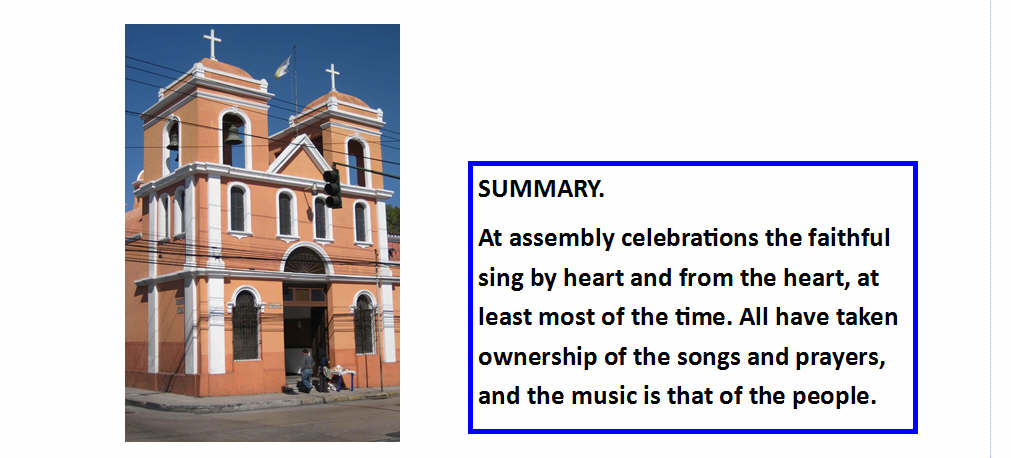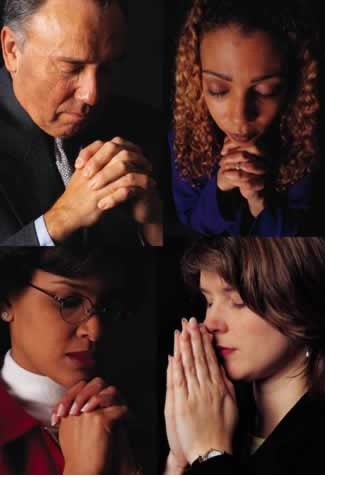
3. Assembly Celebrations
|
This is the third of a series of six. At a priest’s Mass, only a celebrant and an altar server are necessary. At a ministers’ liturgy there is, in addition, a great variety of assistants, but no active participation of the faithful. At the next level, there are several signs suggesting that the whole assembly has become a participating community. The priest and the acolytes can be seen as praying and singing when facing the assembly, and so do the people in the back of the church; there is no more gulf between the active participants in the front and the passive or absent-minded spectators in the back. At assembly liturgies the faithful participate actively because two basic transformations are likely to taken place: the priest and the faithful have taken ownership of the liturgy, and the ministers have become assistants to the assembly rather than actors in the performance. After about forty years in the ministry–since the introduction of English in the Mass in the 1970s–the majority of the priests do not know the Eucharistic prayer by heart. After thirty or forty years of singing, the majority of Catholics do not know the hymns of their parish, in part because the songs are different every week for sake of variety of performance. At assembly celebrations the faithful sing by heart and from the heart (at least most of the time), having taken ownership of a small number of songs they identify with. Similarly, the priest has come to “own” the liturgical prayers rather than read from the Missal. There may be no more choir as an independent unit; instead, there is now a group of dedicated participants who want to sing; and there is no more “maestro” to “conduct” as in a performance. The end result is equality in Christ but differences of charisms. This holds only for a given assembly, e.g. the Sunday morning liturgy; the Saturday or Sunday evening Masses may be quite different. Here is the assembly celebration of an Italian American parish. The church is one hundred percent full, there is a choir in front of the church but it is noticeable neither in sound nor in sight as it blends in with the assembly, and so does the cantor’s voice. At the entrance hymn most people sing, holding their opened hymnal. They sing several stanzas; one to accompany the entrance procession of the priest, and two more after the priest has reached the altar and joins in the singing. The priests then says the introductory prayer like a spontaneous prayer from the heart, by reading it expressively and slowly from the Missal. The Gloria follows an unusual modern tune, but people join in from their hymnal. This assembly was not part of my sample but it is a good example of what could be found elsewhere in the U.S. I found fourteen assembly celebrations in the Guatemalan sample. Here are a few of them. At a small church seating about hundred people, all sang, the acolytes and the priest in front and the people around me. At no time was the priest or the singing group dominant; at all times the priest, the assembly, the small choir, and the guitarist blended together. All sang in one voice Señor ten piedad, because this song is part of their common culture. The same was true of Gloria a Dios en el cielo as it was their common property. The homily on this feast of the Epiphany illustrated the life of the community, “We must all be missionaries. We must go to the people who have become estranged from the church. We must knock at doors, and many will reject us. May the star of Bethlehem guide us, with a missionary spirit.” This is a parish with about 100,000 inhabitants, 25% of which are Catholic, 3% are practicing, and most people are indifferent, according to the parish priest. At many celebrations the liturgy leader takes an important role. At one Mass where the priest was late, he “saved the day” by speaking for ten minutes, giving an improvised exhortation full of passion but with no central message, constantly looking to see if the priest’s procession was on the move from the back of the church. During the Mass the liturgy leader may offer comments about the various readings, at times of greater interest than the homily itself. Assembly celebrations are often longer than average: one Mass of the sample with a few minor liturgical innovations lasted one hour and a half; the pastor told me that, as a consequence, in the six months since his arrival in this parish, attendance had increased rather than decreases.
The liturgical ministries are even more valued when they serve the assembly rather than perform. At one such Sunday celebration, there was a processional entrance of six female acolytes and 10 to 15 adults (lectors, Eucharistic ministers, etc.). “The Lord is among us, announced the liturgy leader. How is God working you your life? We must put the Word into practice.” The cantor was a guitarist-singer; and the choir? The whole assembly, of course! The entrance procession lasted four and a half minutes; it was singing for the sake of singing, while the pastor shook hands and spoke with people on both sides of the aisle. The importance of the faithful was recognized when the celebrant read the numerous Mass intentions handed to him on slips of paper of three different colors: one for petitions, one for thank-you notes, and one for recommendations. When the petitioners were prominent members of the community people applauded; I counted over ten such applause. A community comes to its own most when it can speak its own language in words and music. For most people, especially the young, the organ is as irrelevant an instrument as the harpsichord or the viol of the troubadours. Latin American music needs the rhythm of maracas, guitars, drums and synthesizers. Then people will sing and clap. Then the music becomes joyful community singing. Then the church is likely to be full. At the end of such celebrations, some people may not want to leave; the church may feel like a community hall or community fair where you can stay as long as you want. Some people stay to pray; many hang on. The celebration had been a deep community event transcending words, yet it was nothing out of the ordinary. It was definitely something to come back to. Here the sociological theory that people come for community rather than doctrine seems appropriate yet insufficient: people do not come only for community but also for mystagogy, as will be explained in the next blog. Is your Sunday liturgy a community celebration with the participation from both the ministers and the assembly? Why not? Does the priest own the liturgical prayers and the assembly own the hymns and songs? What can be done? In the next blog I will describe small community celebrations (house and neighborhood churches) with the participation of all.
|
 The singing is prayer rather than concert, yet it may not exclude polyphony. In one church the priest joined in the singing, but he had no sense of tune and no sense of music, and his voice was awkward at all times. A musician God would not have frowned upon it, but a God who looks at the heart may see it differently. At times the singing turned naturally and spontaneously into polyphony, yet there was no music director. The church was full to capacity. There was a welcome team at the doors, and the priest greeted and embraced many people.
The singing is prayer rather than concert, yet it may not exclude polyphony. In one church the priest joined in the singing, but he had no sense of tune and no sense of music, and his voice was awkward at all times. A musician God would not have frowned upon it, but a God who looks at the heart may see it differently. At times the singing turned naturally and spontaneously into polyphony, yet there was no music director. The church was full to capacity. There was a welcome team at the doors, and the priest greeted and embraced many people.